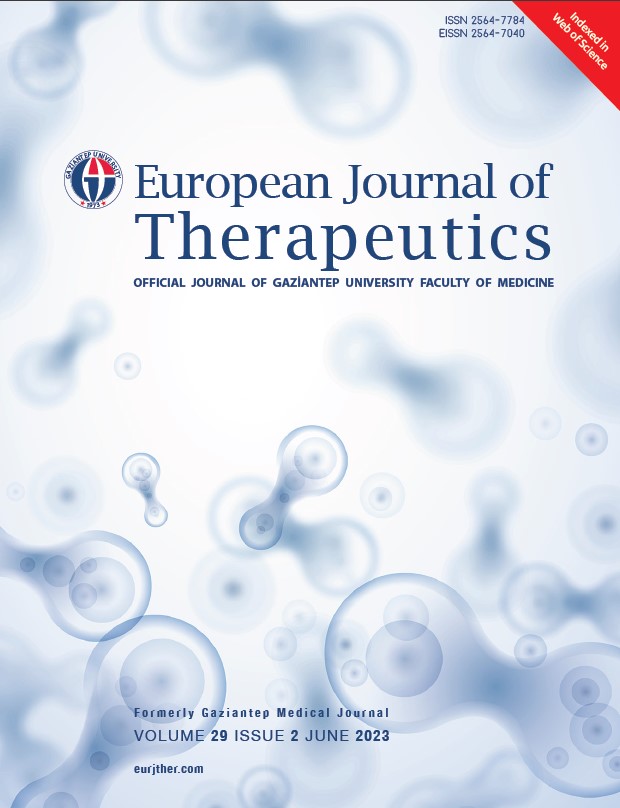Evaluation of the Readability of Turkish Online Resources Related to Laryngeal Cancer
DOI:
https://doi.org/10.58600/eurjther.20232902-449.yKeywords:
Laryngeal cancer, Ateşman readability index, patient education materialsAbstract
Objectives: The aim of this study was to investigate the readability of patient education materials in Turkish about laryngeal cancer.
Methods: Patient education materials were determined by entering the term “gırtlak kanseri”, which is the Turkish equivalent of laryngeal cancer, into the Google search engine. The first 50 websites were determined. Duplicates, academic journals, videos, only graphics or tables were excluded. The websites are categorized as Hospitals, Doctors and General information websites. These websites were evaluated with the Ateşman readability scale.
Results: After applying inclusion and exclusion criteria, 40 websites were analyzed. 19 PEM articles were included on Hospitals websites, 14 on Doctors websites, and 7 on General Information websites. The mean Ateşman readability score of the articles was 58.5±7.06. Hospitals websites mean score was 59.16±6.87. Doctors’ websites average score was 57.25±7.41. General information websites mean score was 59.28±7.59. There was no significant difference in readability scores of Hospitals websites, Doctros websites and General Information websites (P=0.569).
Conclusion: Patient education materials in Turkish about laryngeal cancer are above the desired reading level. Increasing the readability levels of websites to the desired level can help patients reach the right treatment and better compliance to the treatment process.
Metrics
References
Armstrong WB, Vokes DE, Tjoa T, Verma SP (2020) Malignant Tumors of the Larynx. In: Cummings Otolaryngology [Internet]. Seventh Ed. Elsevier Inc. 1564-1595.e11. Available from: https://doi.org/10.1016/B978-0-323-61179-4.00105-8
Society AC. Survival Rates for Laryngeal and Hypopharyngeal Cancers. https://www.cancer.org/cancer/laryngeal-and-hypopharyngeal-cancer/detection-diagnosis-staging/survival-rates.html.
Syme NP, Hoffman HT, Anderson C, Pagedar NA (2020) Management of Early Glottic Cancer. In: Cummings Otolaryngology [Internet]. Seventh Ed. Elsevier Inc. 1596-1616.e4. Available from: https://doi.org/10.1016/B978-0-323-61179-4.00106-X
Kurumu Tİ. Hanehalkı Bilişim Teknolojileri (BT) Kullanım Araştırması, 2022. https://data.tuik.gov.tr/Bulten/Index?p=Hanehalki-Bilisim-Teknolojileri-(BT)-Kullanim-Arastirmasi-2022-45587
Finnie RKC, Felder TM, Linder SK, Mullen PD (2010) Beyond reading level: a systematic review of the suitability of cancer education print and Web-based materials. J Cancer Educ. 25(4):497-505. https://doi.org/10.1007/s13187-010-0075-0
Ritterband LM, Thorndike FP, Cox DJ, Kovatchev BP, Gonder-Frederick LA (2009) A behavior change model for internet interventions. Ann Behav Med. 38(1):18-27. https://doi.org/10.1007/s12160-009-9133-4
Özdemir S, Akça HŞ, Algın A, Kokulu K (2020) Health Literacy in The Emergency Department: A Cross-sectional Descriptive Study. Eurasian J Emerg Med. 19(2):94-7. https://doi.org/10.4274/eajem.galenos.2019.38268
Affairs A complete list of the members of the AHC on HL and the members and staff of the C on S. Health literacy report of the Council on Scientific Affairs (1999 ) Ad Hoc Committee on Health Literacy for the Council on Scientific Affairs, American Medical Association. JAMA [Internet]. 281(6):552-7. https://doi.org/10.1001/jama.281.6.552
The National Library of Medicine (MedlinePlus) (2022) How to Write Easy-to-Read Health Materials [Internet]. 1-6. Available from: https://medlineplus.gov/pdf/health-education-materials-assessment-tool.pdf
Ateşman E (1997) Measuring readability in Turkish. AU Tömer Lang J. 58:71-4.
Lau JTF, Gross DL, Wu AMS, Cheng K man, Lau MMC (2017) Incidence and predictive factors of Internet addiction among Chinese secondary school students in Hong Kong: a longitudinal study. Soc Psychiatry Psychiatr Epidemiol. 52(6):657-67. https://doi.org/10.1007/s00127-017-1356-2
Sarkar U, Karter AJ, Liu JY, Adler NE, Nguyen R, López A, et al (2010) The literacy divide: Health literacy and the use of an internet-based patient portal in an integrated health system-results from the diabetes study of Northern California (DISTANCE). J Health Commun. 15(SUPPL. 2):183-96. https://doi.org/10.1080/10810730.2010.499988
Tahir E, Kent AE (2021) Baş Dönmesi İle İlgili İnternet Kaynaklı Hasta Bilgilendirme Metinlerinin Okunabilirlik Düzeyleri. KBB-Forum. 20(2):163-70.
Kozanhan B, Tutar MS (2017) Readability of Patient Education Texts Presented on the Internet in the Field of Anesthesiology. Turkiye Klin J Anesthesiol Reanim. 15(2):63-70. https://doi.org/10.5336/anesthe.2017-55537
Özduran E, Erkin Y, Hancı V, Taştan A, Tosun DD, Sayan EN (2022) Evaluation of The Readability Of Turkish Internet-Based Patient Education Materials Related To “’Low Back Pain.’” Dokuz Eylül Üniversitesi Tıp Fakültesi Derg. 36(2):135-50. https://doi.org/10.18614/deutip.1174522
Çiftçi HK, Kozanhan B, Solak İ (2020) Evaluation of Readability of Turkish Websites on Substance Addiction. J Depend. 21(1):56-63.
Eryılmaz UN, Külahçı UO (2019) Deri Kanseri Hasta Bilgilendirme Metinlerinin Okunabilirlik Düzeyleri. Dermatoz. 10(1):1-8.
Solak M (2019) Readability of Websites Containing Information About Colorectal Cancer. Harran Üniversitesi Tıp Fakültesi Derg. ;16(3):509-13. https://doi.org/10.35440/hutfd.623920
Narwani V, Nalamada K, Lee M, Kothari P, Lakhani R (2016) Readability and quality assessment of Internet-based patient education materials related to laryngeal cancer. Laryngoscope. 38(4):601-5. https://doi.org/10.1002/hed.23939
Downloads
Published
How to Cite
Issue
Section
Categories
License
Copyright (c) 2023 European Journal of Therapeutics

This work is licensed under a Creative Commons Attribution-NonCommercial 4.0 International License.
The content of this journal is licensed under a Creative Commons Attribution-NonCommercial 4.0 International License.


















